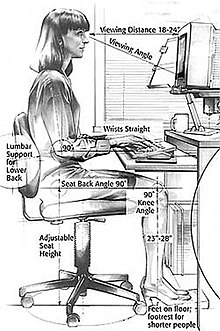The Computer Revolution/Computer Related Injuries and Ergonomics

When thinking about computers in health care, the first things that come to mind are usually the positive benefits of electronic patient charts and speedy prescription delivery. But there are some disadvantages to being around computers all day. Repetitive stress injuries are injuries in which hand, wrist, shoulder, or neck pain is caused by performing the same physical movements over and over again. So by using the computers keyboard at the inappropriate angle or using the wrong technique will cause RSI’s or carpal tunnel syndrome. Carpal tunnel syndrome is a painful and crippling condition affecting the hands and wrists. A computer users eyes can also be affected and they could develop something called computer vision syndrome. Some common symptoms of CVS are eyestrain or fatigue, dry eyes, burning eyes, light sensitivity, blurred vision, headaches, and pain in the shoulders neck and back. All of these problems can be alleviated by the correct use of ergonomics. Ergonomics is the science of fitting a work environment to the people who work there. For instance, to prevent RSI’s, the computer user should make sure the computer and wrists are held at the right angle to prevent injuries. They should also take breaks from working on the computer and do wrist, hand, neck and back exercises. CVS injuries can be prevented by taking frequent breaks form looking at a computer screen.
Computers in a medical field area such as Nursing, is now a much needed device. Most hospitals are up and running off of computers that help nurses and doctors enter patient history. Because there is such a need, there are now requirements that have been set forth by OSHA to protect medical staff. The irony of working in a hospital, is that the staff may also be the patient. In such cases where this may occur do to a computer related injury for example are carpal tunnel syndrome and back issues. Standards have been put into place to ease into proper usage of computer based hardware. OSHA requires that all medical staff have training for usage of hardware such as computers that will fit in the field with proper body alignment. OSHA has a software based training option that will teach medical staff for proper ergonomics. OSHA also has specific rights for an employee. According to The Online Journal of Nursing Informatics [1], the following rights were created specifically for nurses and medical staff.
1) the right number of computers
2) available at the right locations
3) viewable at the right height
4) with the right size monitor
5) set to the right resolution
Elkind, E., Finley, M. & Narloch, R. (October, 2008). Ergonomics for the Placement of Computers on a Nursing Unit. Online Journal of Nursing Informatics (OJNI), 12, (2).